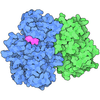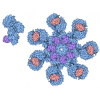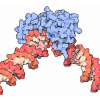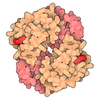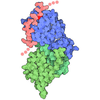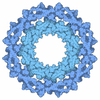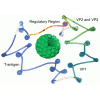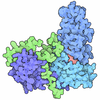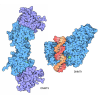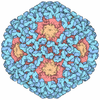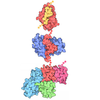+ データを開く
データを開く
- 基本情報
基本情報
| 登録情報 | データベース: PDB / ID: 9c8u | ||||||||||||
|---|---|---|---|---|---|---|---|---|---|---|---|---|---|
| タイトル | Human PRC2 - RvLEAM (short) (1:6 molar ratio), cross-linked 10 min | ||||||||||||
 要素 要素 |
| ||||||||||||
 キーワード キーワード | DNA BINDING PROTEIN / Human polycomb repressive complex 2 / RvLEAM / air-water-interface | ||||||||||||
| 機能・相同性 |  機能・相同性情報 機能・相同性情報protein localization to pericentric heterochromatin / hepatocyte homeostasis / cellular response to trichostatin A / regulation of gliogenesis / negative regulation of striated muscle cell differentiation / regulation of kidney development / [histone H3]-lysine27 N-trimethyltransferase / sex chromatin / CAF-1 complex / negative regulation of keratinocyte differentiation ...protein localization to pericentric heterochromatin / hepatocyte homeostasis / cellular response to trichostatin A / regulation of gliogenesis / negative regulation of striated muscle cell differentiation / regulation of kidney development / [histone H3]-lysine27 N-trimethyltransferase / sex chromatin / CAF-1 complex / negative regulation of keratinocyte differentiation / histone H3K27 trimethyltransferase activity / negative regulation of retinoic acid receptor signaling pathway / response to tetrachloromethane / cerebellar cortex development / primary miRNA binding / random inactivation of X chromosome / regulatory ncRNA-mediated heterochromatin formation / skeletal muscle satellite cell maintenance involved in skeletal muscle regeneration / histone H3K27 methyltransferase activity / negative regulation of cardiac muscle cell proliferation / facultative heterochromatin formation / ubiquitin-modified histone reader activity / negative regulation of cardiac muscle hypertrophy / positive regulation of cell cycle G1/S phase transition / NuRD complex / NURF complex / regulation of cell fate specification / negative regulation of stem cell population maintenance / DNA replication-dependent chromatin assembly / ESC/E(Z) complex / Transcription of E2F targets under negative control by p107 (RBL1) and p130 (RBL2) in complex with HDAC1 / regulation of stem cell differentiation / negative regulation of stem cell differentiation / RSC-type complex / pronucleus / chromatin silencing complex / protein-lysine N-methyltransferase activity / Polo-like kinase mediated events / cardiac muscle hypertrophy in response to stress / Transcription of E2F targets under negative control by DREAM complex / G1 to G0 transition / positive regulation of dendrite development / cardiac muscle cell proliferation / histone H3 methyltransferase activity / histone methyltransferase complex / synaptic transmission, GABAergic / DNA methylation-dependent constitutive heterochromatin formation / histone methyltransferase activity / lncRNA binding / negative regulation of G1/S transition of mitotic cell cycle / ATPase complex / spinal cord development / negative regulation of gene expression, epigenetic / Sin3-type complex / positive regulation of stem cell population maintenance / G1/S-Specific Transcription / oligodendrocyte differentiation / Transcriptional Regulation by E2F6 / negative regulation of transcription elongation by RNA polymerase II / RNA Polymerase I Transcription Initiation / histone deacetylase complex / G0 and Early G1 / negative regulation of cell differentiation / positive regulation of protein serine/threonine kinase activity / subtelomeric heterochromatin formation / ribonucleoprotein complex binding / pericentric heterochromatin / Transcriptional regulation of brown and beige adipocyte differentiation by EBF2 / Cyclin E associated events during G1/S transition / positive regulation of epithelial to mesenchymal transition / RNA polymerase II core promoter sequence-specific DNA binding / nucleosome binding / Cyclin A:Cdk2-associated events at S phase entry / keratinocyte differentiation / spleen development / protein localization to chromatin / : / Regulation of TP53 Activity through Acetylation / Deposition of new CENPA-containing nucleosomes at the centromere / negative regulation of cytokine production involved in inflammatory response / positive regulation of GTPase activity / positive regulation of MAP kinase activity / B cell differentiation / cellular response to leukemia inhibitory factor / SUMOylation of chromatin organization proteins / enzyme activator activity / negative regulation of cell migration / liver development / thymus development / hippocampus development / liver regeneration / central nervous system development / ERCC6 (CSB) and EHMT2 (G9a) positively regulate rRNA expression / ubiquitin binding / Regulation of PTEN gene transcription / PRC2 methylates histones and DNA / transcription corepressor binding / Regulation of endogenous retroelements by KRAB-ZFP proteins / Defective pyroptosis / Regulation of endogenous retroelements by Piwi-interacting RNAs (piRNAs) 類似検索 - 分子機能 | ||||||||||||
| 生物種 |  Homo sapiens (ヒト) Homo sapiens (ヒト) | ||||||||||||
| 手法 | 電子顕微鏡法 / 単粒子再構成法 / クライオ電子顕微鏡法 / 解像度: 3.1 Å | ||||||||||||
 データ登録者 データ登録者 | Abe, K.M. / Li, G. / He, Q. / Grant, T. / Lim, C. | ||||||||||||
| 資金援助 |  米国, 3件 米国, 3件
| ||||||||||||
 引用 引用 |  ジャーナル: Nat Commun / 年: 2024 ジャーナル: Nat Commun / 年: 2024タイトル: Small LEA proteins mitigate air-water interface damage to fragile cryo-EM samples during plunge freezing. 著者: Kaitlyn M Abe / Gan Li / Qixiang He / Timothy Grant / Ci Ji Lim /  要旨: Air-water interface (AWI) interactions during cryo-electron microscopy (cryo-EM) sample preparation cause significant sample loss, hindering structural biology research. Organisms like nematodes and ...Air-water interface (AWI) interactions during cryo-electron microscopy (cryo-EM) sample preparation cause significant sample loss, hindering structural biology research. Organisms like nematodes and tardigrades produce Late Embryogenesis Abundant (LEA) proteins to withstand desiccation stress. Here we show that these LEA proteins, when used as additives during plunge freezing, effectively mitigate AWI damage to fragile multi-subunit molecular samples. The resulting high-resolution cryo-EM maps are comparable to or better than those obtained using existing AWI damage mitigation methods. Cryogenic electron tomography reveals that particles are localized at specific interfaces, suggesting LEA proteins form a barrier at the AWI. This interaction may explain the observed sample-dependent preferred orientation of particles. LEA proteins offer a simple, cost-effective, and adaptable approach for cryo-EM structural biologists to overcome AWI-related sample damage, potentially revitalizing challenging projects and advancing the field of structural biology. #1:  ジャーナル: Science / 年: 2023 ジャーナル: Science / 年: 2023タイトル: Structural basis for inactivation of PRC2 by G-quadruplex RNA. 著者: Jiarui Song / Anne R Gooding / Wayne O Hemphill / Brittney D Love / Anne Robertson / Liqi Yao / Leonard I Zon / Trista E North / Vignesh Kasinath / Thomas R Cech /  要旨: Polycomb repressive complex 2 (PRC2) silences genes through trimethylation of histone H3K27. PRC2 associates with numerous precursor messenger RNAs (pre-mRNAs) and long noncoding RNAs (lncRNAs) with ...Polycomb repressive complex 2 (PRC2) silences genes through trimethylation of histone H3K27. PRC2 associates with numerous precursor messenger RNAs (pre-mRNAs) and long noncoding RNAs (lncRNAs) with a binding preference for G-quadruplex RNA. In this work, we present a 3.3-Å-resolution cryo-electron microscopy structure of PRC2 bound to a G-quadruplex RNA. Notably, RNA mediates the dimerization of PRC2 by binding both protomers and inducing a protein interface composed of two copies of the catalytic subunit EZH2, thereby blocking nucleosome DNA interaction and histone H3 tail accessibility. Furthermore, an RNA-binding loop of EZH2 facilitates the handoff between RNA and DNA, another activity implicated in PRC2 regulation by RNA. We identified a gain-of-function mutation in this loop that activates PRC2 in zebrafish. Our results reveal mechanisms for RNA-mediated regulation of a chromatin-modifying enzyme. | ||||||||||||
| 履歴 |
|
- 構造の表示
構造の表示
| 構造ビューア | 分子:  Molmil Molmil Jmol/JSmol Jmol/JSmol |
|---|
- ダウンロードとリンク
ダウンロードとリンク
- ダウンロード
ダウンロード
| PDBx/mmCIF形式 |  9c8u.cif.gz 9c8u.cif.gz | 355.4 KB | 表示 |  PDBx/mmCIF形式 PDBx/mmCIF形式 |
|---|---|---|---|---|
| PDB形式 |  pdb9c8u.ent.gz pdb9c8u.ent.gz | 260.1 KB | 表示 |  PDB形式 PDB形式 |
| PDBx/mmJSON形式 |  9c8u.json.gz 9c8u.json.gz | ツリー表示 |  PDBx/mmJSON形式 PDBx/mmJSON形式 | |
| その他 |  その他のダウンロード その他のダウンロード |
-検証レポート
| アーカイブディレクトリ |  https://data.pdbj.org/pub/pdb/validation_reports/c8/9c8u https://data.pdbj.org/pub/pdb/validation_reports/c8/9c8u ftp://data.pdbj.org/pub/pdb/validation_reports/c8/9c8u ftp://data.pdbj.org/pub/pdb/validation_reports/c8/9c8u | HTTPS FTP |
|---|
-関連構造データ
| 関連構造データ |  43625MC  8vy3C  9c8vC M: このデータのモデリングに利用したマップデータ C: 同じ文献を引用 ( |
|---|---|
| 類似構造データ | 類似検索 - 機能・相同性  F&H 検索 F&H 検索 |
- リンク
リンク
- 集合体
集合体
| 登録構造単位 | 
|
|---|---|
| 1 |
|
- 要素
要素
-Polycomb protein ... , 2種, 2分子 BC
| #1: タンパク質 | 分子量: 83181.922 Da / 分子数: 1 / 由来タイプ: 組換発現 / 由来: (組換発現)  Homo sapiens (ヒト) / 遺伝子: SUZ12, CHET9, JJAZ1, KIAA0160 Homo sapiens (ヒト) / 遺伝子: SUZ12, CHET9, JJAZ1, KIAA0160発現宿主:  参照: UniProt: Q15022 |
|---|---|
| #2: タンパク質 | 分子量: 42386.273 Da / 分子数: 1 / 由来タイプ: 組換発現 / 由来: (組換発現)  Homo sapiens (ヒト) / 遺伝子: EED Homo sapiens (ヒト) / 遺伝子: EED発現宿主:  参照: UniProt: O75530 |
-タンパク質 , 3種, 3分子 DAF
| #3: タンパク質 | 分子量: 47709.527 Da / 分子数: 1 / 由来タイプ: 組換発現 / 由来: (組換発現)  Homo sapiens (ヒト) / 遺伝子: RBBP4, RBAP48 Homo sapiens (ヒト) / 遺伝子: RBBP4, RBAP48発現宿主:  参照: UniProt: Q09028 |
|---|---|
| #4: タンパク質 | 分子量: 86017.859 Da / 分子数: 1 / 由来タイプ: 組換発現 / 由来: (組換発現)  Homo sapiens (ヒト) / 遺伝子: EZH2, KMT6 Homo sapiens (ヒト) / 遺伝子: EZH2, KMT6発現宿主:  参照: UniProt: Q15910, [histone H3]-lysine27 N-trimethyltransferase |
| #6: タンパク質 | 分子量: 32881.473 Da / 分子数: 1 / 由来タイプ: 組換発現 / 由来: (組換発現)  Homo sapiens (ヒト) / 遺伝子: AEBP2 Homo sapiens (ヒト) / 遺伝子: AEBP2発現宿主:  参照: UniProt: Q6ZN18 |
-タンパク質・ペプチド / 非ポリマー , 2種, 8分子 E

| #5: タンパク質・ペプチド | 分子量: 3436.009 Da / 分子数: 1 / 由来タイプ: 組換発現 / 由来: (組換発現)  Homo sapiens (ヒト) / 遺伝子: JARID2, JMJ Homo sapiens (ヒト) / 遺伝子: JARID2, JMJ発現宿主:  参照: UniProt: Q92833 |
|---|---|
| #7: 化合物 | ChemComp-ZN / |
-詳細
| 研究の焦点であるリガンドがあるか | N |
|---|---|
| Has protein modification | Y |
-実験情報
-実験
| 実験 | 手法: 電子顕微鏡法 |
|---|---|
| EM実験 | 試料の集合状態: PARTICLE / 3次元再構成法: 単粒子再構成法 |
- 試料調製
試料調製
| 構成要素 | 名称: Polycomb Repressive Complex 2 / タイプ: COMPLEX / Entity ID: #1-#6 / 由来: RECOMBINANT |
|---|---|
| 分子量 | 実験値: NO |
| 由来(天然) | 生物種:  Homo sapiens (ヒト) Homo sapiens (ヒト) |
| 由来(組換発現) | 生物種:  |
| 緩衝液 | pH: 7.5 |
| 試料 | 包埋: NO / シャドウイング: NO / 染色: NO / 凍結: YES |
| 急速凍結 | 凍結剤: ETHANE |
- 電子顕微鏡撮影
電子顕微鏡撮影
| 実験機器 | 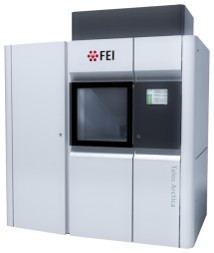 モデル: Talos Arctica / 画像提供: FEI Company |
|---|---|
| 顕微鏡 | モデル: FEI TALOS ARCTICA |
| 電子銃 | 電子線源:  FIELD EMISSION GUN / 加速電圧: 200 kV / 照射モード: FLOOD BEAM FIELD EMISSION GUN / 加速電圧: 200 kV / 照射モード: FLOOD BEAM |
| 電子レンズ | モード: BRIGHT FIELD / 最大 デフォーカス(公称値): 2500 nm / 最小 デフォーカス(公称値): 1000 nm |
| 試料ホルダ | 凍結剤: NITROGEN |
| 撮影 | 電子線照射量: 50 e/Å2 フィルム・検出器のモデル: GATAN K3 BIOQUANTUM (6k x 4k) |
- 解析
解析
| EMソフトウェア | 名称: PHENIX / カテゴリ: モデル精密化 |
|---|---|
| CTF補正 | タイプ: NONE |
| 3次元再構成 | 解像度: 3.1 Å / 解像度の算出法: FSC 0.143 CUT-OFF / 粒子像の数: 366459 / 対称性のタイプ: POINT |
 ムービー
ムービー コントローラー
コントローラー












 PDBj
PDBj
